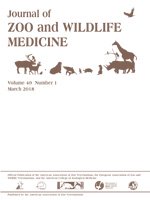Reproductive lesions have been described in various nonhuman primate species, including rhesus macaques (Macaca mulatta), cynomolgus macaques (Macaca fascicularis), baboons (Papio spp.), squirrel monkeys (Saimiri sciureus), and chimpanzees (Pan spp.); however, there are few publications describing reproductive disease and pathology in Japanese macaques (Macaca fuscata). A retrospective evaluation of postmortem reports for two captive M. fuscata populations housed within zoos from 1982 through 2015 was completed, comparing reproductive diseases diagnosed by gross pathology and histopathology. Disease prevalence, organs affected, and median age at death between the two institutions was also compared. Fifteen female captive M. fuscata, ranging in age from 15 to 29 yr were identified with reproductive tract lesions, including endometriosis, endometritis, leiomyoma, leiomyosarcoma, and adenomyosis. No significant differences were identified in disease prevalence, organs affected, and median age of death between the two institutions. Endometriosis was the most common disease process identified and was found in 10 of the 15 cases (66.7%), followed by leiomyoma (4 of 15; 26.7%). In four cases (26.7%), severe endometriosis and secondary hemorrhage was indicated as the cause of death or the primary reason for humane euthanasia. These findings were compared with a separate population of Japanese macaques managed within a research facility in the United States, with a prevalence of endometriosis of 7.6%. This study discusses possible risk factors and potential treatment options for the management of endometriosis in captive M. fuscata.
How to translate text using browser tools
1 March 2018
LESIONS OF THE FEMALE REPRODUCTIVE TRACT IN JAPANESE MACAQUE (MACACA FUSCATA) FROM TWO CAPTIVE COLONIES
Andrew J. Gall,
June E. Olds,
Arno Wünschmann,
Laura E. Selmic,
James Rasmussen,
Anne D. Lewis
ACCESS THE FULL ARTICLE
endometriosis
Japanese macaque
leiomyoma
Macaca fuscata
reproduction





